
44 minute read
Campus Update
Students Grow and Thrive despite Pandemic Challenges
Carmen Cole
Advertisement
CARMEN COLE (carmen@byu.edu) IS A DESIGNER AT THE RELIGIOUS STUDIES CENTER.
Six different BYU students. Six different perspectives. Yet all are united in the experience we call the COVID-19 pandemic.
Before the pandemic, students freely roamed BYU campus, workplaces, social spots, businesses, and church buildings. Now they are physically six feet apart. School, work, and church services have been limited in size or moved to online formats. Wearing a mask to the bank is no longer frowned on—it is required.
Life Changes
The pandemic has impacted some students’ lives more than others and each in different ways. Jae Martinez, a sophomore from Mansfield, Texas, studying psychology, and Carrie Greene, a sophomore from Orem studying elementary education, were both serving Latter-day Saint missions when the pandemic hit.
“The pandemic came when I was halfway through my mission,” Jae says. “I felt like the floor was pulled right out from under my feet. I had to learn all over again, but in a completely different way, how to be a missionary. Then upon coming home, I had to learn all over again—but in a completely different way—how to be a college student.”
Carrie also experienced changes as a missionary. “I was on my mission when the pandemic first broke out, and I was able to see how it greatly changed missionary work,” she says. “We weren’t able to go out and knock on doors, and finding new people was tricky at first.” Now that she’s home and back at school, “I miss being able to do more spontaneous things; you often have to make reservations or call your friend or family member before just showing up.”
Emily Warner would probably agree with that. A junior from Tehachapi, California, studying biodiversity and conservation, Emily says, “It’s been hard staying inside and having to do school online, and it’s kind of sad sometimes when a lot of the activities are limited.”
“Fortunately, I haven’t had any family members or friends who have died or been seriously ill because of COVID, so for me, life itself is still very much the same,” says a married student who preferred to remain anonymous. “But I recognize that life has become very different for many people. I get up every day, and I sleep every night. My husband and I are still in school, and we still have our jobs and our health. Other than the minor inconveniences of mask wearing and stores closing early, we haven’t been too affected at all.”
One element of life that has changed for Cara Nickels, a senior from St. George studying English, is certainty. “Prior to last February, I confidently made plans weeks and months in advance, purchasing tickets for flights, applying to study abroad programs, seeking jobs, et cetera,” she says. “Yet so much was canceled by the pandemic, and so much continues to balance precariously on the verge of cancellation. It’s difficult to predict what will come next and how the pandemic may continue to affect our lives, and that has made it difficult to plan for the future.”
For Isaac Romer, a first-year student from Lorena, Texas, studying music education, “the most obvious difference is found in my social life. I loved hanging out
Photo by Jaren Wilkey, © 2020 BYU Photo.
with my friends in my classes, but now that almost never happens. It’s been an entire semester and a half, and my social interactions are mostly with my roommates, my family home evening group, my ministers, and my siblings that live on campus.”
“The pandemic has certainly tested my self-reliance at times,” Isaac continues. “I think of the devotional that President Worthen gave before the start of school at the end of the summer [2020] where he said, ‘If we emerge from the pandemic unscathed but unchanged, we will have missed out on the full benefit of this unique experience.’ Luckily now I have some really awesome roommates that have this same mindset, so being with them more often has only helped me.”
For most of the students interviewed, the people they are able to associate with during the pandemic have been a blessing, bringing deeper and better relationships.
Carrie says, “The upside is that those who I do socialize with have become some of my closest friends; we have really had to prioritize spending time together. Dating and friendships seem less casual and more meaningful and purposeful.”
With the switch to online instruction, Cara “was able to take classes remotely while spending time with family. Instead of returning to my parents’ home, however, I went and lived with my oldest sister for nearly half a semester. Living with her and her kids was a real blessing, and I feel lucky to have a fairly big part in the lives of her children in particular as they grow up.”
Jae adds, “While people are now more physically distant, it seems that everyone is emotionally more connected. This may be due to the fact that every single human being on the planet right now has at least one shared experience. That gives absolutely everyone something to connect with. I definitely miss hugs, and people being less physically guarded.”
God Is in the Details
Along with the adjustments in social life, education, and physical distancing, we wanted to know how students are faring spiritually. Many students mentioned how these trials have helped them grow. They listed prayer, testimony, journaling, scripture study, devotionals, religion classes, serving others, and having the proper mindset as resources that have helped.
The dramatic changes in Jae’s missionary and subsequent college life were very humbling for her. “The pandemic has impacted my religious life drastically, in all ways for the better,” Jae says. “These [experiences] have humbled me because I saw how in life we can become comfortable and stagnant. We tend to cling to routines and what is constant. However, the only constant is the gospel. If the pandemic has taught me anything, it’s that. Life as you know it could change in an instant. This inspired me to change the way I study that gospel. I started not only looking for what I need now, but truly tried to seek revelation from Heavenly Father on what I need for the future. I have learned the value of being prepared.”
Prayer and scripture study have helped Jae the most. She comments, “All the crazy things that have happened in the scriptures in the past don’t seem so crazy anymore. I am more willing to seek comfort and guidance. The constant reminder that God fulfills his promises gives me peace. No matter how turbulent times may be, we can count on him.”
Carrie has appreciated the power of prayer during this time. “One thing that has helped me spiritually is to be genuine in my prayers about my challenges and frustrations, but also about my victories and joys, and then listen for help and answers from God,” she says. “I also have taken more time to ponder my testimony and then express it through poetry, art, and journaling. I know those things will be a really valuable reminder to me in the future when I’m experiencing other trials.”
Emily has also found herself journaling more since the pandemic hit. “I think probably the biggest change is that I’ve started writing in my journal more about the things I’m grateful for, and reading my scriptures, and trying to reach out to others where I can. I’m trying to do more service and recognize that we’re all in this together, so it’s good to help one another.”
Cara mentioned the trials associated with online church but has been grateful for personal study and religion classes to supplement the Sunday meeting changes. “It was really difficult not being able to attend church in person for so long,” she says. “Sundays began to feel like just another Saturday, and it became harder to keep the Sabbath. My religion classes did help with that, since being
“The pandemic has brought so many disappointments and worst-case scenarios, but I’ve also lived through them, and that’s not nothing.” —Cara
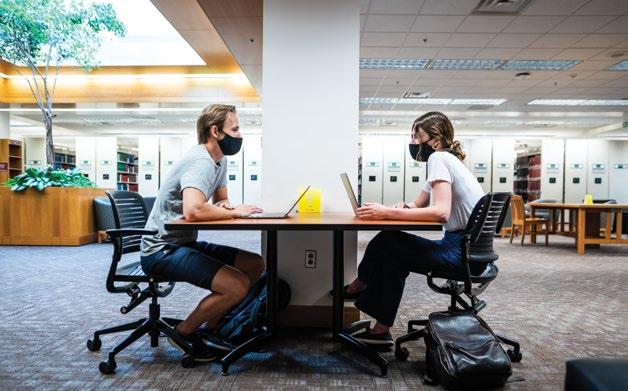
Photos by Nate Edwards and Tyler Richardson, © 2020 BYU Photo.

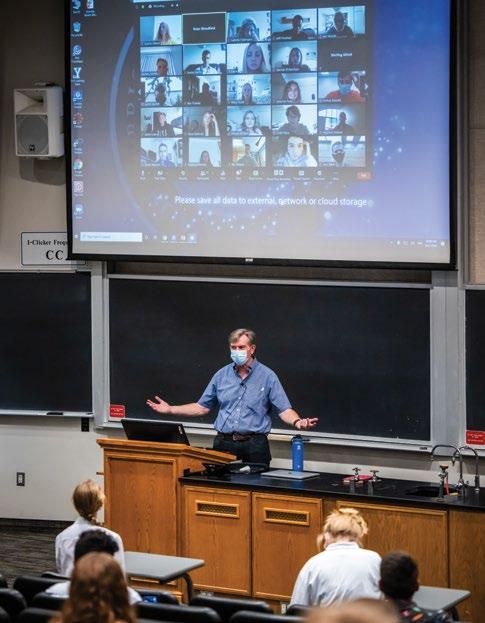
In-person and virtual classes. Photo by Nate Edwards, © 2020 BYU Photo.
assigned conference talks and religious readings each week filled part of the gap left by not having church. There has been a greater emphasis on personal study and an outpouring of resources that have been very useful.”
For Better or Worse
Most of the students think the pandemic has changed them overall for the better. An introvert, Cara said, “Now that I don’t have social events forcing me to go out and socialize, the circle of people I talk to has grown smaller and smaller. Yet it’s also made me miss such socialization, so maybe once pandemic conditions lighten, I’ll be brave enough to be a little more extroverted as I try to recover my social life. I do also think the pandemic has made me more resilient in some ways. It brought so many disappointments and worst-case scenarios, but I’ve also lived through them, and that’s not nothing.”
The pandemic has helped Carrie become more compassionate. “The pandemic has helped me to see the sufferings of others with more empathy; I want to help them where I can and comfort them,” she says. “The pandemic has also helped me to feel that yearning to hear from our living prophet and apostles.”
“Because of the politics that were forced into the pandemic (and because of all the social unrest of 2020), the year has been more exhausting mentally and emotionally,” says an anonymous student. But “I think all of the political/social unrest has brought me closer to my Heavenly Parents because I’ve had to rethink and ponder some of my religious beliefs. I know that my Heavenly Parents love us and want the best for us, so I accept that for many questions, I must continue to wait in patience until I can know the answers (even if that waiting only ends after this life).”
Emily says these experiences have helped her to not take things for granted, and she recognizes the hand of God more in her life. For example, “Sometimes I’ll get lonely or have a bad day, and I’ve had friends that have texted me at the right moment or called me just when I needed it.”
The pandemic has changed Jae “absolutely” for the better. “I feel like my view of the gospel, and of humanity, has been expanded,” she says. “I understand the value of stillness, which is hard to learn in a very busy and chaotic society. I have spent a lot of time with my thoughts, which has allowed me to take inventory on them and change the things I don’t like or [that] aren’t right.”
Isaac perhaps said it best. “The pandemic has been like a mission companion: after living with it for a while you start to realize where your weaknesses are. The pandemic has shown me that I am not as social as I thought I once was, because now I have to make a special effort if I want social interaction.” But “the pandemic has changed me for the better.”
Despites the many challenges and changes, it’s good to see ways in the lives of these students in which the “tender mercies of the Lord are over all” (1 Nephi 1:20). Even during a pandemic, BYU students are fighting back— choosing faith over fear—and thriving.
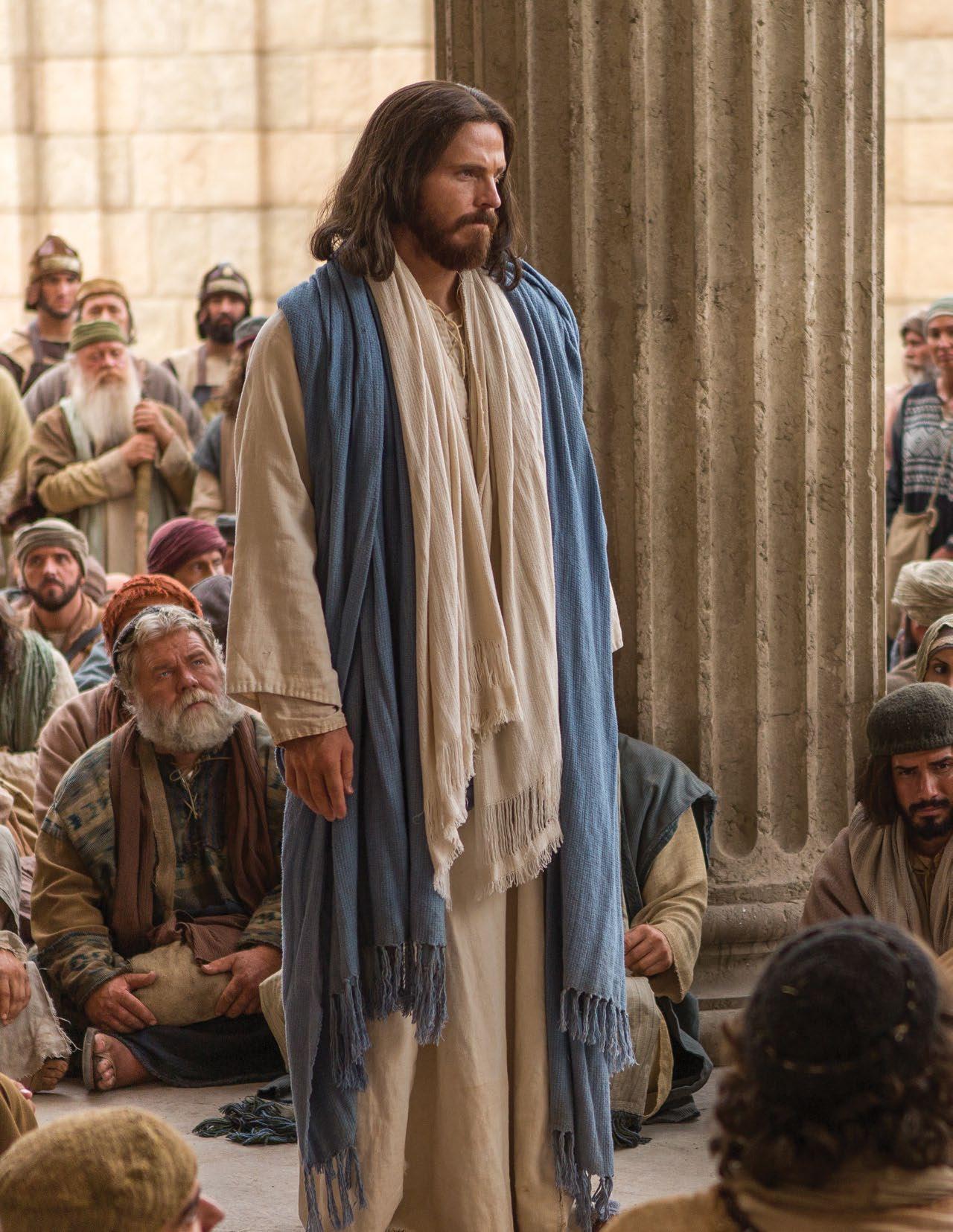

FROM SCRIPTURE TO SCREEN
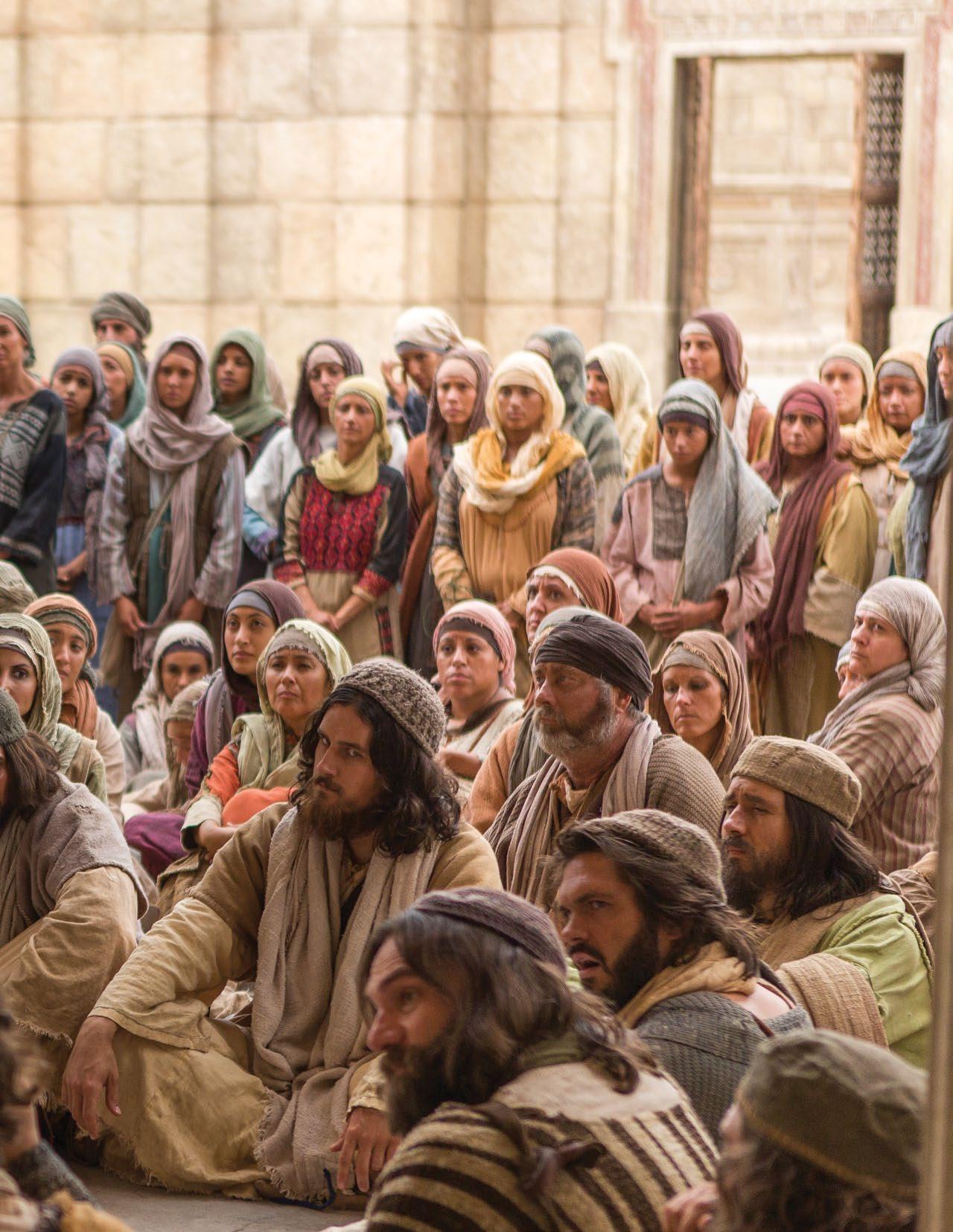
FILMS DEPICTING JESUS AND THE WORLD OF THE NEW TESTAMENT
Matthew J. Grey and Scott C. Esplin


FROM AN INTERVIEW BY SCOTT C. ESPLIN, PUBLICATIONS DIRECTOR FOR THE BYU RELIGIOUS STUDIES CENTER, WITH MATTHEW J. GREY, ASSOCIATE PROFESSOR OF ANCIENT SCRIPTURE AT BYU.
Above: photo by Matt Reier. Courtesy of Intellectual Reserve, Inc. Previous page: photo by Cody Bell. Courtesy of Intellectual Reserve, Inc.
Esplin: How did you get interested in the genre of biblical cinema and, specifically, films depicting Jesus?
Grey: My professional interest in Jesus films began when I started teaching courses on the New Testament at BYU. In doing so, I quickly found that a careful and historically contextualized reading of the Gospels often challenged the preconceived notions many students have about Jesus, including his appearance, demeanor, and relationship to early Judaism, as well as the cultural world in which he lived. As I would ask students what informed their previous assumptions, the most common response indicated that they were influenced by the ways in which Jesus is depicted in art or in the movies. This prompted a feeling of professional obligation to become more familiar with Jesus films and how they contribute to students’ understanding of the New Testament so I could better mediate between their preconceptions and what we find in the scriptural text.
Esplin: What have you learned about the ways Jesus has been depicted in film?
Grey: Biblical films have always both reflected and influenced the religious sensitivities of the generations in which they are produced, and it has been fascinating to explore how, over the last hundred years, certain cinematic themes and images have helped shape public perception of Jesus in particular. For example, beginning with the silent films of the early twentieth century and continuing through the Hollywood epics of the 1960s and ’70s, Jesus was typically depicted in ways that closely parallel the European artistic tradition with which religious audiences have long been familiar. In these depictions, Jesus is most often portrayed as a middle-aged northern-European who is well groomed, wears long white robes, has a beatific countenance, teaches in opposition to his Jewish contemporaries, functions in a highly sanitized world, and is extremely limited in his emotions, all of which reflects traditional notions of Jesus’s divinity but distances him both from his first-century Jewish context and from his human surroundings. As a result, such depictions—advertently or inadvertently—have often made it difficult for film audiences to connect with Jesus since in the portrait of him they are used to seeing he doesn’t seem to get dirty on the roads of first-century Galilee, be at home in his Jewish environment, or even interact with others on a human level.
However, in a careful and historically contextualized reading of the New Testament Gospels we see a Jesus who physically does not stand out from his contemporaries (but who instead was eastern Mediterranean in his ethnicity, complexion, and appearance), would have worn the common clothing of Roman Palestine (a short tunic and mantle, rather than a long white robe), operates fully within his early Jewish context (rather than in opposition to it), and expresses a wide range of human emotions that make him a much more compelling and dynamic personality than audiences are used to seeing.
I have enjoyed trying to help students navigate these differences between biblical cinema and the scriptural text—not in a way that dismisses the artistic qualities of Jesus films (which often contain beautiful images, convey inspiring emotions, and should be appreciated in their own right), but in a way that allows students to become more aware of the influence films have on popular perceptions, deepens students’ scriptural literacy, and increases their historical awareness. I have found that by placing Jesus films into conversation with the New Testament and other historical sources, students can have a much richer experience both reading the Gospels and watching scripture-based media.
Esplin: How have Jesus films changed or developed in recent decades?
Grey: Beginning around the turn of the millennium, there have been a number of subtle but important shifts in the way Jesus has been depicted on screen. For example, in films of the last twenty years we have begun to see hints of Jesus’s humanity that go beyond the more pious portrayals of their cinematic predecessors, such as allowing him to smile or laugh, showing him dance or banter with his disciples, or showing him experience emotions of pain, frustration, and annoyance along with feelings of happiness, understanding, and sympathy for those around him. I believe that these shifts are a fascinating reflection of the changing spiritual and entertainment needs of audiences in the early twenty-first century. Unlike their moviegoing parents and grandparents (who embraced more traditional forms of biblical storytelling and the image of an emotionally distant deity), viewers of the current generation seem to resonate more with a depiction of Jesus they can relate to, whose human experience contributes to his divine attributes, and who extends compassion to those who are broken, marginalized, or longing for a sense of purpose (all of which has gradually begun to appear in more recent Jesus films).
Also, within the last twenty years, films have started to depict Jesus in more ethnically appropriate ways (by casting non-European actors to play the role), to show more of the grittiness of first-century life (by recreating the poverty of Galilean villages), and to highlight ways in which Jesus operated within his early Jewish religious

setting (by having him say Jewish prayers, wear Jewish religious items, and observe Jewish holy days). These developments have not only made important strides toward reflecting a greater historical accuracy in Jesus films, but have attempted to speak to the spiritual needs of modern viewers, many of whom want to see Jesus working in a more realistic setting and yearn to engage with a more relatable style of biblical storytelling.
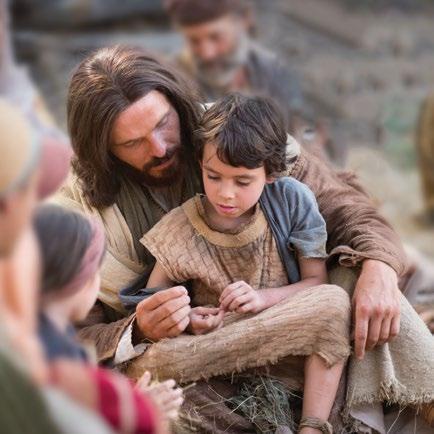
Photo by Cody Bell. Courtesy of Intellectual Reserve, Inc.
Esplin: In your view, how do these depictions impact Latter-day Saints?
Grey: Like other religious viewers, Latter-day Saints are heavily influenced by the images and messages of the films they watch. Historically, the more traditional Jesus films seem to have had a significant impact on Latter-day Saint perceptions of Jesus and the world in which he operated. This can have a lot of spiritual benefits (especially as many of these films have provided valuable inspiration and faith-informing perspectives), but it can also have its disadvantages. For example, if Latter-day Saint viewers are accustomed to imagining Jesus as an emotionally distant divine being that is fundamentally different from his human surroundings (as seen in traditional film depictions), that is going to have an impact on their religious experience, including ways they view God and their relationship to him. On the other hand, as Latter-day Saints interact with films that try to bridge the gap between Jesus’s divinity and humanity (as many are beginning to do), that can have an effect on their spiritual experience as well; only now, they can start relating to Jesus on a human level—fully appreciating his divine qualities, but also seeing visually that Jesus knows what it’s like to walk on a dirty street, laugh at a dinner table with his friends, be disappointed when something doesn’t go quite right, and experience complex relationships.
Also, now that Latter-day Saint audiences are beginning to see films in which Jesus more fully engages with his Jewish surroundings and appreciates the richness of his Jewish heritage, it can refine the way they view Jesus’s teachings and their perception of other faith communities. This can help inspire them to experience holy envy and to see the beauty in other faith traditions (such as early Judaism) while still recognizing the distinction of their own. These are all ways in which the powerful medium of film can affect our scriptural literacy, our historical awareness, our religious experience, and our approach to Christian discipleship.
Esplin: What can you share with us about Church efforts to produce films about Jesus?
Grey: For many years, Latter-day Saints mostly relied on “outside” productions for their biblical media. In the early 1990s, though, the Church began to produce its own Jesus films for use in seminary classes, missionary efforts, and home instruction. The first of these was a short video called the Lamb of God which, as hoped, inspired many students, missionaries, and families by showing scenes from the ministry, suffering, and resurrection of Christ from a Latter-day Saint perspective. It is interesting to note, however, that when the Church began producing its own material, its depiction of Jesus and its approach to scripture followed the most conservative trends of traditional Jesus films. For example, in the Lamb of God Jesus has only a few lines (all of which are reverently spoken in King James English), the orchestral musical score carries most of the film’s emotional weight, and it takes great care to not diverge from the biblical text, all of which reflects a respectfully cautious treatment of the scriptural content but at the same time limits the film’s ability to tell a compelling story (as good cinema is meant to do).
This challenging tension between scriptural cautiousness and cinematic appeal continued into the early 2000s when the Church produced its next major Jesus film, The Testaments. While mostly a Book of Mormon film, it occasionally depicts scenes from Jesus’s New Testament ministry. These scenes mostly attempted to recreate traditional pieces of art (such as the well-known Carl Bloch paintings), and thus offered a more familiar portrait of Jesus rather than one that challenged viewers to think about him in new ways. These approaches to depicting Jesus continued in the Life of Jesus Christ Bible videos (2011–13), for which the Church built an elaborate Jerusalem set in Goshen, Utah, to film over a hundred Gospel scenes, all shown with strict adherence to the King James text of the New Testament.
The most recent and innovative development among Church-produced Jesus films was The Christ Child—a twenty-minute film about the birth of Jesus for the Church’s 2019 Light the World campaign. This production represented an important step forward for biblical storytelling in Church media in several ways. First, in The Christ Child we begin to see more of the complexity of scriptural characters, such as Mary and Joseph who laugh and smile at one another and who clearly connect to each other on an emotional level. There’s also some fictional dialogue, which is very rare in Latter-day Saint Bible films; this dialogue is in Aramaic, but it’s inspiring to see, hear, and feel aspects of the story’s first-century setting. Finally, The Christ Child made an unprecedented effort to present a historically informed portrayal of the Christmas story by incorporating several refinements to the traditional story
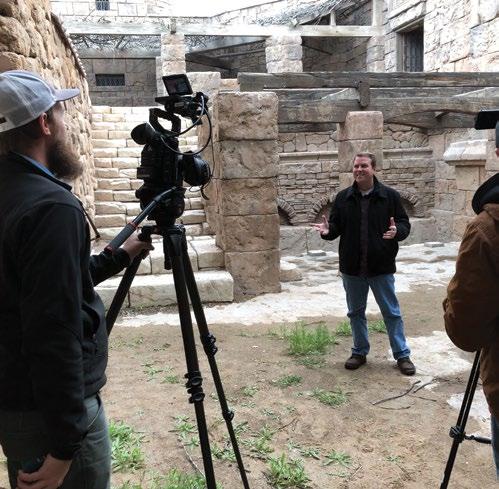

based on historical or archaeological research. All of these facets of The Christ Child contributed to the success and enthusiastic reception of the film, both within and outside of the Latter-day Saint community.
Esplin: What role do scholars like yourself play in these productions? How have you and others been personally involved?
Grey: Scholars are often involved at various levels in these films, typically to offer scriptural or historical advice to the directors, screenwriters, set designers, or actors. For instance, I was honored to be invited as one of the historical consultants on The Christ Child, along with colleagues such as Richard Holzapfel (a former BYU professor who provided valuable guidance throughout the production process), David Calabro (an ancient language expert who wrote the Aramaic dialogue), and Jason Combs (an ancient scripture professor who offered insightful “behind the scenes” commentary). For me, involvement in The Christ Child began in the scriptwriting phase when I was asked to review an early draft and offer feedback. It was gratifying to help with some of the scriptural and historical aspects of the script, such as maintaining the film’s scriptural integrity by separating Luke’s account of Jesus’s birth from Matthew’s account. As a result, the first half of the film shows the story from Luke 2 of Mary and Joseph coming to Bethlehem and finding that there was no room in the family house (which is a more historically plausible scenario than traditional depictions of this scene), as well as the experience of the shepherds with their witness of the newborn Jesus. In the second half, the film shifts to the story in Matthew 2 by showing the wise men follow the star until they come to the house in Bethlehem where Joseph, Mary, and “the young child” Jesus are living
(details from Matthew’s account that do not often appear in film). In these ways, we were able to feature some interesting scriptural perspectives and try to make the film more historically informed in terms of the family situation, travel dynamics, and even the different ages of Jesus, while at the same time telling an emotionally compelling story.
As the film moved on to production, I was also able to be on set, interact with the actors, and have some rich conversations with the production team about various historical and scriptural issues the film could address. For example, in between scenes I was talking with Brooklyn McDaris (the actress who played Mary) and, when I found out that she was a professional singer, shared with her the story from Luke 1 of Mary singing a scripturally informed hymn (the “Magnificat”) in response to her miraculous

Matthew Grey with Brooklyn McDaris (the actress who played Mary) on the film set for The Christ Child. Photos courtesy of Matthew Grey.
conception; even though that particular story was not a part of the script, both Brooklyn and John Foss (the film’s director) became excited about the scriptural possibility it opened up and spontaneously added a beautiful scene in which Mary sings a Hebrew lullaby to the baby Jesus as a nod to her expression of praise in Luke 1. This type of interaction between filmmakers and historians can result in powerful media that is both historically informed and emotionally compelling, thus representing the best of both worlds.
Esplin: What do you hope viewers learn from these productions?
Grey: One of the great strengths of cinema is its ability to bring a topic to life for its audiences. In the case of Jesus films, such productions have a remarkable potential to connect modern viewers with ancient scripture in an emotional and visual way that sometimes the biblical text can’t do alone. Along with recognizing this great strength of biblical cinema, however, I would also hope that students or viewers of these films recognize that film is ultimately an artistic medium. Like other forms of art, film excels at being able to provide emotional resonance, symbolic reflection, and creative beauty for its viewers (all of which should be fully appreciated in its own right), but film is not typically meant to be a historical documentary that presents the most current research on its subject (that is the work of trained historians). As a result, I would hope that—along with enjoying the various artistic aspects of what they are watching—viewers allow Jesus films to point them toward the most reliable scriptural sources and biblical scholarship for a more robust, informed, and nuanced understanding of the story. Learning to appreciate these various layers of film can deeply enrich the viewing experience and help facilitate a deeper level of scriptural literacy.
Esplin: There has been great interest in a recent television show called The Chosen. What can you share with our readers about this most recent attempt to depict the life of Jesus?
Grey: The Chosen is the first multiseason television drama (by evangelical filmmaker Dallas Jenkins) that seeks to tell the story of Jesus “through the eyes of those who knew him.” The series is an inspiring attempt to imagine in fictional ways the backstories of Jesus’s earliest disciples, their complex personalities and relationships, and their transformative encounters with Jesus. In the


I WOULD HOPE THAT . . . VIEWERS ALLOW JESUS FILMS TO POINT THEM TOWARD THE MOST RELIABLE SCRIPTURAL SOURCES AND BIBLICAL SCHOLARSHIP FOR A MORE ROBUST, INFORMED, AND NUANCED UNDERSTANDING OF THE STORY.
Filming The Chosen television series. © 2020 VidAngel. All rights reserved.
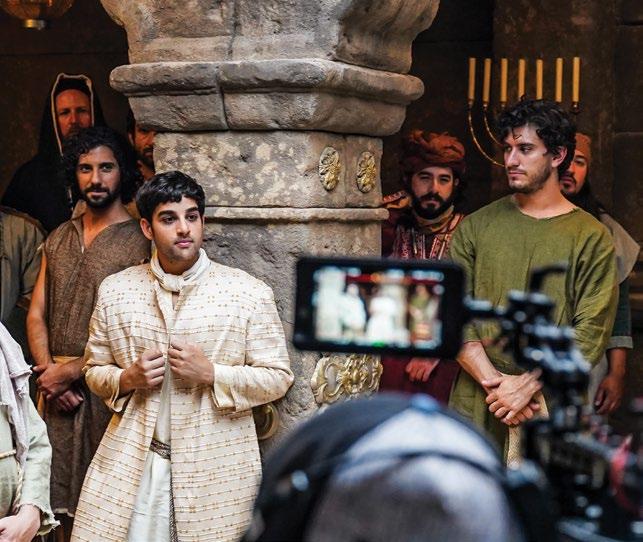
process, it offers a portrayal of scriptural characters with their strengths, weaknesses, triumphs, and struggles that allows viewers to see themselves on the challenging but joyful path of discipleship. It also explores the humanness of Jesus in a relatable way that goes beyond more traditional depictions by allowing him to feel joy in his miracles, wrestle with God in knowing how to fulfill his mission, laugh, joke, sing, and dance with his disciples, and extend compassion to those who are broken, marginalized, or longing for a sense of purpose, all while maintaining a deep respect for Jesus’s divine identity and mission.
This compelling portrayal of Jesus and the disciples in The Chosen definitely belongs in the category of “scriptural fiction” (it takes several liberties with the Gospel texts) and struggles to accurately depict various historical matters (such as the nature of early Judaism, daily life in first-century Galilee, and the extent of Roman military occupation in the region), but its relatable style of biblical storytelling offers many viewers their first opportunity to connect deeply with the characters and world of the New Testament on screen; as such, The Chosen represents an important step forward in faith-based biblical cinema. It has also been interesting to watch this series become one of the rare “outside” scriptural media projects embraced within the Latter-day Saint community in recent decades, as reflected in its sponsorship by VidAngel (a streaming service owned by Latter-day Saints), its now-regular appearances on BYUtv, and the official invitation by the Church to film its second season at the Jerusalem set in Goshen.
Esplin: As one who studies the context, history, and life of Jesus, what do you hope to see in future films depicting him?
Grey: As a historian of early Judaism and an archaeologist who focuses on Roman Palestine, it has been great to see the increasing interest by filmmakers in depicting Jesus in ethnically appropriate ways, showing more realistic recreations of daily life in first-century Galilee, and placing Jesus within his Jewish context. I would hope that, going forward, future films build on these trends and that we continue to see even higher levels of historical accuracy in terms of casting, costuming, sets and props, and the social, political, and religious setting of the Jesus story. These are all aspects of the New Testament world we continue to learn more about through historical, archaeological, and biblical research, and it would be fun to see more of this scholarship being incorporated in Jesus films—both as a way to show a respect for the Jesus story by getting it right and to better contextualize Jesus’s teachings for audiences by showing their originally intended significance.
Also, now that Jesus films are starting to move past some of the pageantry of previous generations, I would hope that future projects continue to boldly explore aspects of Jesus’s personality, ministry, and teachings that we have not often seen on screen. For example, very few films have attempted to reflect Jesus’s apocalyptic worldview, have fully engaged his more challenging social commentary, or have shown him immersed in first-century Jewish religious debate. These are all aspects of Jesus’s life and message that are prominent in the New Testament Gospels but that have, for the most part, yet to be explored in film. Incorporating them into the more familiar cinematic portraits could be a powerful way for future films to help modern audiences more fully appreciate, understand, and relate to Jesus.
Esplin: As we conclude, how has your study of films about Jesus helped you come closer to the Savior?
Grey: For me, placing Jesus films, the New Testament text, and historical sources into thoughtful conversation has prompted valuable questions that I might not otherwise have asked about a wide range of issues, including Jesus’s appearance, personality, teachings, and ongoing social relevance, as well as the nature of scriptural writings. Often these questions come as I find myself wondering why film directors made certain decisions, how I might have presented things differently as a believing historian, and what the implications of those decisions might be for the spiritual experience of the viewers. I often find that asking those type of questions facilitates richer inspiration as a teacher, academic insights as a scholar, and spiritual experiences as a believer, all of which have been a great blessing in my personal efforts to get to know Jesus better, to help increase the faith and scriptural literacy of my students, and to strengthen my own discipleship.
Multimedia Resources Tell Restoration Story
By Carmen Cole
CARMEN COLE (carmen@byu.edu) IS A DESIGNER AT THE RELIGIOUS STUDIES CENTER.
Lights! Camera! Action! Exciting things are happening in the world of Religious Education multimedia. From TV programs that discuss the gospel in a talk show-type atmosphere to informative podcasts and scholarly online videos, Religious Education faculty are “preparing the way of the Lord” (Doctrine and Covenants 34:6) through multiple multimedia resources. Here is just a sampling of good things to come.
Foundations of the Restoration Videos
When Religious Education changed its core curriculum a few years ago, Alex Baugh, professor and chair of Department of Church History and Doctrine, saw the need for more and newer multimedia resources. Baugh has been heading production since last year on Church history videos to supplement in or out of class instruction for the Foundations of the Restoration religion class (REC C 225). Foundations of the Restoration is a required religion course for all BYU students, and Baugh wants students to have the best learning experience possible, and media can be a powerful component to help students learn and feel.
“The nature of our learning is so different today,” he says. “I think students expect a visual experience. It’s what they enjoy and how many of them like to learn.”
Religious Education received a generous endowment to make various types of multimedia for teaching purposes, and Baugh moved forward by creating a list of video topics that would supplement the Foundations of the Restoration class curriculum. The videos are filmed and produced three at a time and feature three or four faculty in each. Twenty-five videos are planned, each to be about twenty minutes long. Sixteen have been completed and are available for anyone to view online through the RSC website.
“When I started teaching at BYU we didn’t have any of this kind of media,” Baugh says. “There was very little media that could supplement teaching.” Now, students are able to watch a particular video in advance of class to prepare for the upcoming class lecture and presentation. In his class, Professor Baugh has his students summarize in writing what they learned from the video, what was new, and what they understand now that they didn’t know before.
Baugh reads all of the students’ responses. “I think it’s a great aide for teaching,” he adds. The videos help students “learn, understand, and feel more deeply the things of the mind and the feelings of the heart.”
The best part about the videos? “While they are meant for our students, we’re glad to share them with everybody,” Baugh said. He is convinced that we will “flood the earth,” as Church President Ezra Taft Benson (1899–1994) foresaw, not
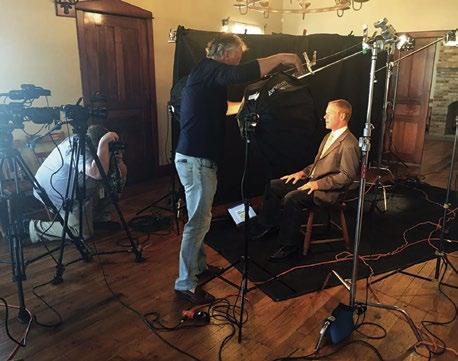
Glenn Rawson and Dennis Lyman, video producers for Foundations of the Restoration video production. Courtesy of History of the Saints, Inc.
only through printing and publishing the Book of Mormon and preaching the restored gospel, but through the use of online media. “Somebody in the Netherlands, or Australia, or anywhere else in the world who is interested in learning about the Restoration can access the videos because they are on the RSC website. Gospel doctrine teachers can view them to help them prepare for their Come, Follow Me lessons. Seminary and Institute instructors are free to use them in their classes. We hope that church members, or anyone else for that matter, will watch them as well. We’re more than happy to share,” he says. The episode titled “What Makes a Revelation? The History of the Doctrine and Covenants” is scheduled to air on KSL-TV at 9:30 a.m. before general conference on Saturday, April 3, 2021. The Foundations of the Restoration videos are available online at rsc.byu.edu/ media under the link titled “Doctrine and Covenants/Church History Videos.”
Roundtable Scripture Discussions
“Roundtable Scripture discussions usually consist of four Religious Education faculty members discussing various scriptural passages from a specific book of scripture: Book of Mormon, Pearl of Great Price, Doctrine and Covenants, [or] Old and New Testament,” says Gaye Strathearn, professor of ancient scripture. The faculty sit together around a table to discuss the topics—a common method for academic discussion—and the practice hence offers the series its name, Roundtables.
“Initially I participated in some of the early discussions on the Old and New Testaments and the Book of Mormon,” Strathearn says. “When Religious Education decided to do some episodes on the new cornerstone classes, we decided to start with the Teachings and Doctrines of the Book of Mormon [class]. I was the associate department chair and was asked to take responsibility for the new episodes. We used some of the topics taught in the class as the basis for our discussions. I invited faculty who were interested in participating to sign up for the topics that they would like to discuss, and then I tried to find combinations of faculty who had different strengths and interests that would complement each other.” Strathearn also found artwork to enhance each video episode and reviewed each episode “many times for accuracy.”
These videos used to air exclusively on KBYUtv but are now available online at rsc.byu.edu/media.
Y Religion Podcast
“The Y Religion Podcast is a podcast that brings some of the published research and writing of the BYU Religion faculty to the everyday Saint,” says Anthony Sweat, executive producer of the Y Religion podcast and associate teaching professor of Church history and doctrine. “Each year, BYU religion professors publish hundreds of studies that deal with subjects related to the Church, but many students and Church members never learn from them as these are published in a variety of journals and presses and venues. This podcast brings this research into one place to enlighten the everyday seeker of truth. In each episode we discuss why the study was done, why it matters, and why the professor chooses faith.”

Left to right: Stephanie Dibb Sorensen, Daniel Becerra, and Barbara Morgan Gardner on the set of Come Follow Up.
“[The Y Religion Podcast] is engaging. It is enlightening. And it is edifying. The work of my colleagues in BYU Religious Education is top-notch and fabulous, and this is a free, easy, accessible way for you to enjoy their research and insights.” —Anthony Sweat
Sweat, a regular podcast user, realized a few years ago that podcasts, with their “engaging format,” could also be utilized to share the religious scholarship of BYU faculty with the world. He created a few demos, submitted a proposal, and received the “backing and green light to move forward and form a committee.” The faculty members on the committee—Ryan Sharp, Casey Griffiths, and Brad Wilcox—conduct the interviews for the podcasts. Sweat acts as host for each podcast, and BYU students record, edit, and mix the audio. About the podcast, Sweats admits, “I love it. I am a teacher and one who likes to use any medium to reach and teach learners, and this is a fun and growing medium to do so.”
The Y Religion podcast is growing in both popularity and number of listeners. “More and more people listen all the time, into the tens of thousands monthly,” Sweat says. “The podcast has even charted in the top twenty religion podcasts in America a few times. It is engaging. It is enlightening. And it is edifying. The work of my colleagues in BYU Religious Education is top-notch and fabulous, and this is a free, easy, accessible way for you to enjoy their research and insights as you work around your home, drive, or even exercise! I think this podcast is the very definition of seeking learning by study and also faith. You won’t be disappointed.” The Y Religion podcast is available on all major podcast platforms, including Apple, Spotify, Google, Pandora, and Stitcher. You can also play it directly from the web. Just Google “Y Religion Podcast,” go to yreligion.byu .edu, or visit rsc.byu.edu/media.
Come Follow Up
When BYUtv wanted to create a weekly TV show to “help viewers engage more deeply and meaningfully with the scripture readings in the Come, Follow Me curriculum,” they didn’t need to look any further than the faculty in BYU Religious Education. Barbara Morgan Gardner, associate professor of Church history, and Daniel Becerra, assistant professor of ancient scripture, are the moderators on BYUtv’s Come Follow Up.
“Each week on the show our discussion centers on the [Come, Follow Me] scripture block for that week,” says Becerra. “The idea is that we come together to ‘follow up’ on what we have learned and to discuss the questions that we have. We also have a special guest each week who has unique training or life experience relevant to what we plan to discuss.”
“The program is unique in that it offers a platform for a diversity of voices (both in the studio and at home) to participate in gospel teaching and learning,” he adds. “The show is founded upon the assumption we all have something to contribute to help [one] another come unto Christ.”
Becerra initially balked at the idea of being a moderator on the show—he isn’t, after all, an actor. But BYUtv assured him that they wanted normal people who could talk authentically about the gospel. “Normal I can do,” he says. “Also, I am committed to the notion that discipleship can look different, so a project which recognized the value of diverse voices for gospel learning appealed to me.”
Becerra appreciates the opportunity to work both with his co-moderator Gardner and the guests on the show, and recognizes how much he learns from them. He says the best part about being a moderator is “learning from our guests, and not just the weekly ‘specialists.’ I have been surprised at how consistently our youngest members of the audience (sometimes as young as seven or eight) have such wise insights. I also love hearing the testimonies of persons from such diverse walks of life.”
Come Follow Up airs every Sunday at 1 pm ET/10 a.m. PT on BYUtv. You can also stream past episodes anytime on the BYUtv app or on the BYUtv website, byutv.org.
a brief history of the byu religious education student symposium
by Casey Paul Griffiths
CASEY PAUL GRIFFITHS (casey_griffiths@byu.edu) IS AN ASSISTANT TEACHING PROFESSOR OF CHURCH HISTORY AND DOCTRINE AT BYU.
In the spring of 1998, Richard E. Bennett attended a new faculty seminar where Henry B. Eyring, then the Commissioner of the Church Educational System, challenged the teachers at BYU to find ways to help their undergraduate students publish their own work. President Eyring felt more opportunities to publish might “help them gain admission to graduate school and also help them prepare for future careers.”1 While teaching at the University of Manitoba a few years earlier, Dr. Bennett had organized a history-focused symposium for college students, and he felt the time was right to bring a similar forum to the students at BYU.2 He soon secured the support of Robert L. Millet, the dean of Religious Education, and his department chair, Raymond S. Wright, and was appointed the first chair of the Student Symposium. A planning committee consisting of Todd Parker, John Livingstone, Cynthia Doxey Green, Patty Smith, and a student named Jeremy Wells was appointed to put together the first symposium. With a budget of four thousand dollars to pay for promotion, publication, and a luncheon for the students, the team set to work.
As they worked together, the committee labored to formulate the purpose and aims of the symposium. Dr. Bennett recalled designing the symposium to “improve student writing and research skills; to foster a climate of student scholarship in Church History (soon afterward the symposium was opened to include Ancient Scripture); to reward excellence by providing prizes and awards; and to improve the academic profile of Religious Education.” One goal stood out above the rest, “to provide the rising generation of Latter-day Saint students a forum in which they could express their views and interpretations of Church History at a time when technological advances were exposing more youth to questions about our past.”3
The first Student Symposium was held April 1–2, 1999, at the Harman Building on BYU campus. The committee chose forty-eight presenters out of ninety-nine who submitted papers to the symposium. Over the years the symposium was simplified to a one-day event, typically
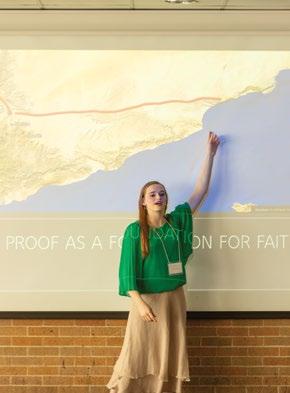

Left: Student giving presentation at Student Symposium. Right: Richard Bennett, founder and the first chair of the Student Symposium, wanted to improve student writing and research skills, foster a climate of student scholarship, and improve the academic profile of Religious Education. Photos by Richard B. Crookston.
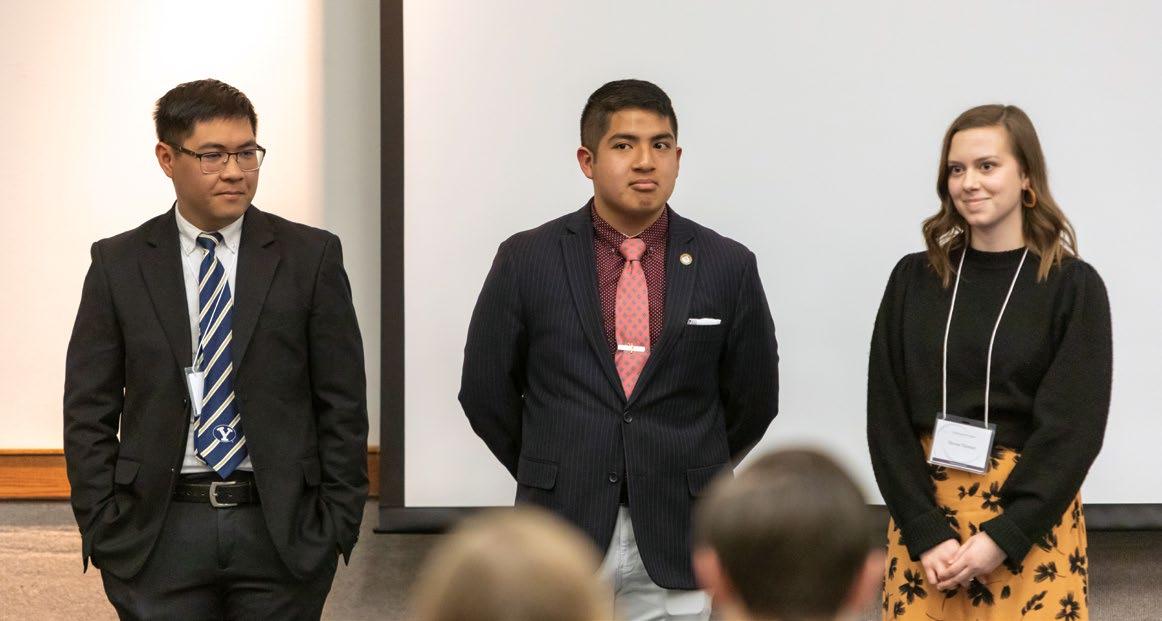
Student presenters handling questions and answers at the 2020 Student Symposium. Photo by Richard B. Crookston.
held in February. Students present in several sessions held in the Wilkinson Center, followed by a banquet attended by representatives from several prominent academic organizations including the Mormon History Association, the Maxwell Institute, Book of Mormon Central, the Ensign Peak Foundation, the Interpreter Foundation, and others. Students who submit excellent papers receive prizes ranging from the grand prize of two thousand dollars down to five hundred dollars. Prize-winning papers are published in a volume prepared by the RSC and student authors are often recruited by attendees to publish their papers in academic journals. After twenty years of the symposium, thousands of students have had the opportunity to present, and thousands more have attended.
Papers for the symposium cover a wide variety of topics, ranging from Church history to scriptural studies to social issues. Titles of papers from just the last few years include “Reconnecting with the Divine Feminine” (2020), “Helping Eating Disorders through the Gospel” (2016), “Understanding the Disciple’s Path with Game Theoretic Mathematics” (2017), “Disease or Devils: Exploring Mental Illness in the New Testament” (2018), and “‘Princes Also Shall Worship:’ The History and Conversion of a Tongan Prince” (2018). In 2020 the top prize was awarded to a paper titled “From Animosity to Acceptance: How Early Latter-day Saint Suffragists Redefined America’s View of Latter-day Saints.” Brady Earley, the author of this award-winning paper, remarked, “During a year in which we celebrated the centennial of the passage of the 19th amendment to the U.S. Constitution, I could think of no better group to highlight than those early Latter-day Saint women.”4
For some students, the symposium shifted their academic trajectory. Brooke LeFevre was considering changing her major from psychology to history when she first submitted her work to the symposium. “I didn’t know if I love history enough to pursue it as a career, so I decided to write a research paper on a woman who caught my attention, Mary Elizabeth Rollins Lightner,” Brooke later remembered. “I visited archives, and as I tried to piece together the life of this wonderful witness of the Restoration, I fell in love with not only learning history but the historical process. I was hooked, and I was shocked when that paper won second place in the 2018 symposium.” Brooke is now working on a PhD in history.5
The symposium provided an opportunity for graduate students to submit papers as well. Quinten Barney submitted a paper titled “The Symbolic and Liminal
Function of the Number Three in the Book of Mormon.” He later remembered, “I compared my findings with how the number is used in the Bible and argued that both texts use the number three in much the same way. I was fairly confident my research was original, interesting, and made a significant contribution to Book of Mormon studies.” Quinten was surprised and delighted when he was awarded a thousand-dollar prize from Book of Mormon Central for his paper.6 Tyler Beagley, another graduate student, submitted a paper comparing King Benjamin’s
sermon with Matthew 25. “It was a fantastic experience submitting the paper, getting notified of its acceptance and working further to improve it, and then presenting at the symposium,” Tyler later recalled.7
Over the years a number of future faculty members tested the waters of academia as undergraduates through the means of the Student Symposium. Julie Frederick, now an adjunct instructor in Religious Education, remembered, “I presented with another classics student (Jon Rainey) papers that included analyses using our study of the Greek language to better understand the New Testament. I remember being flattered that Frank Judd, who was faculty moderator, praised our engagement with the original language, and our use of it for exegesis.”8 Josh Sears, now a faculty member in Ancient Scripture, submitted a paper he wrote in a class taught by Jeffrey Marsh. “I had always enjoyed learning about the scriptures,” he remembered, “but his was the first hint that maybe I could do something more serious with what I learned—that encouragement stayed with me after my mission and impacted what courses I took and what career decisions I made.”9
Daniel Becerra, another faculty member in Ancient Scripture, recalled that “it provided me an opportunity to apply the skills of academic inquiry that I had cultivated to explore questions about the gospel that were meaningful to me. In this sense, it gave me a glimpse of what the marriage of ‘study’ and ‘faith’ can look like (Doctrine and Covenants 88:118). I learned how fulfilling it was to teach and learn about the gospel using all of the intellectual and spiritual tools available to me.”10 J. B. Haws, now an associate dean of Religious Education, looks back on his symposium experience with fond memories. “The Student Symposium was really, for me, the first chance to think about and to talk about religious and historical topics in this kind of setting. It opened my mind to new possibilities and ways of thinking. I had a great lunch, great opportunity to interact with the BYU faculty, and a great opportunity to think seriously about important things.”11
Symposium alumni now mentor other new students and sharpen their research, writing, and presenting skills. Building on a foundation of twenty years of excellence in student scholarship, the future is bright for the Student Symposium. The symposium marks a bittersweet milestone in 2021 with the departure of Richard Bennett, the founder of the symposium, who retired from Religious Education this year to serve as the director of the Mormon Trail Center in Omaha, Nebraska. But Dr. Bennett leaves behind a rich legacy of mentorship, scholarship, and success. From a spark of inspiration in a faculty meeting to a program that has blessed the lives of thousands in the Church, the Student Symposium has become a modern school of the prophets, a place to “study and learn, and become acquainted with all good books, and with languages, tongues, and people” (Doctrine and Covenants 90:15).
Notes
1. Richard E. Bennett, “The Religious Education Student Symposium: A
Short History” (unpublished, 2021). 2. Mark D. Ogletree, “The Religious Education Student Symposium,” BYU
Religious Education Review, Fall 2014, 24. 3. Bennett, 1. 4. Brady Early, email to author, January 13, 2021. 5. Brooke LeFevre, email to author, January 15, 2021. 6. Quinten Z. Barney, email to author, January 13, 2021. 7. Tyler Beagley, email to author, January 13, 2021. 8. Julie Frederick, email to author, January 11, 2021. 9. Joshua Sears, email to author, January 19, 2021. 10. Daniel Becerra, email to author, January 19, 2021. 11. J. B. Haws, email to author, January 12, 2021.






